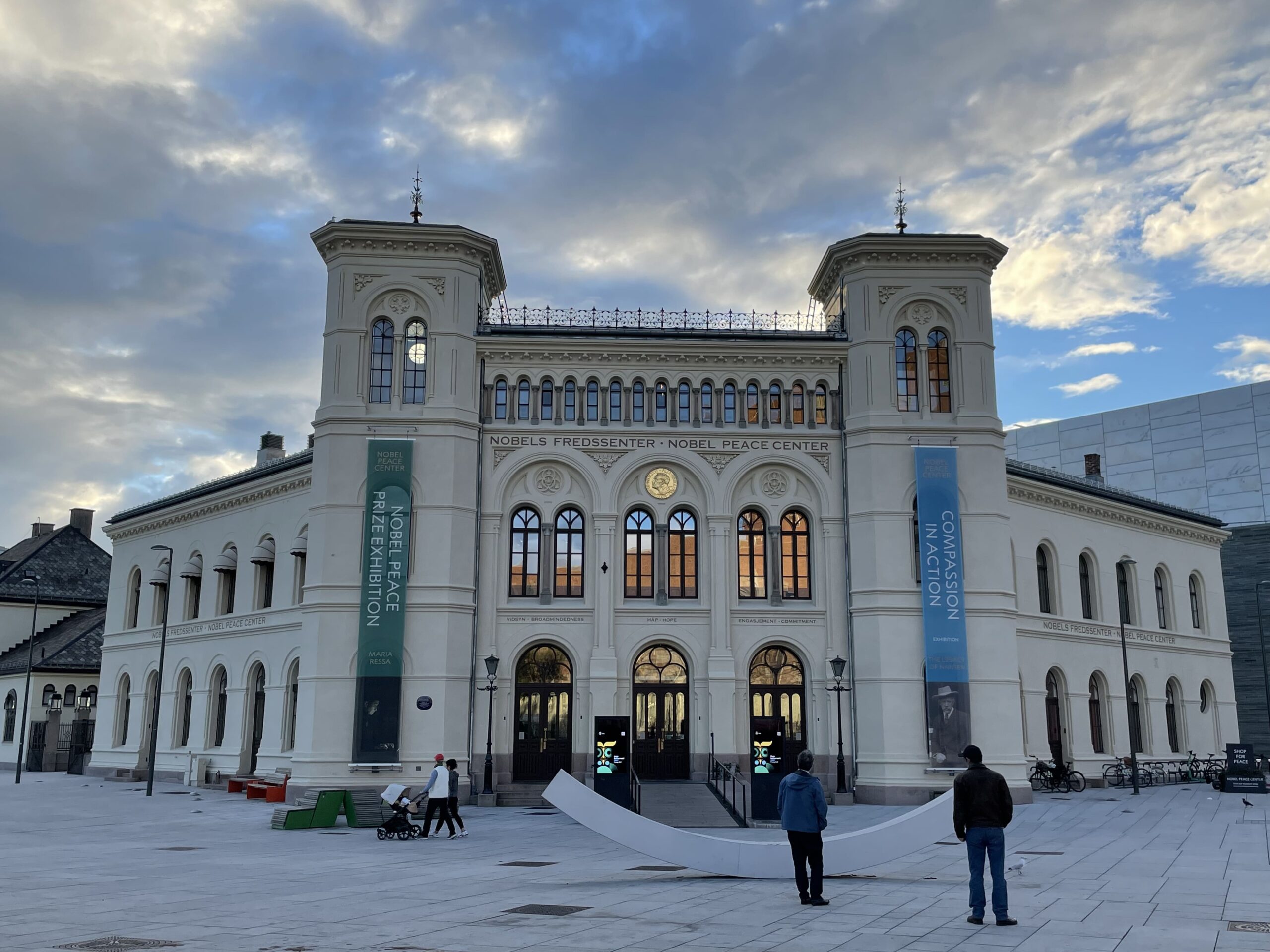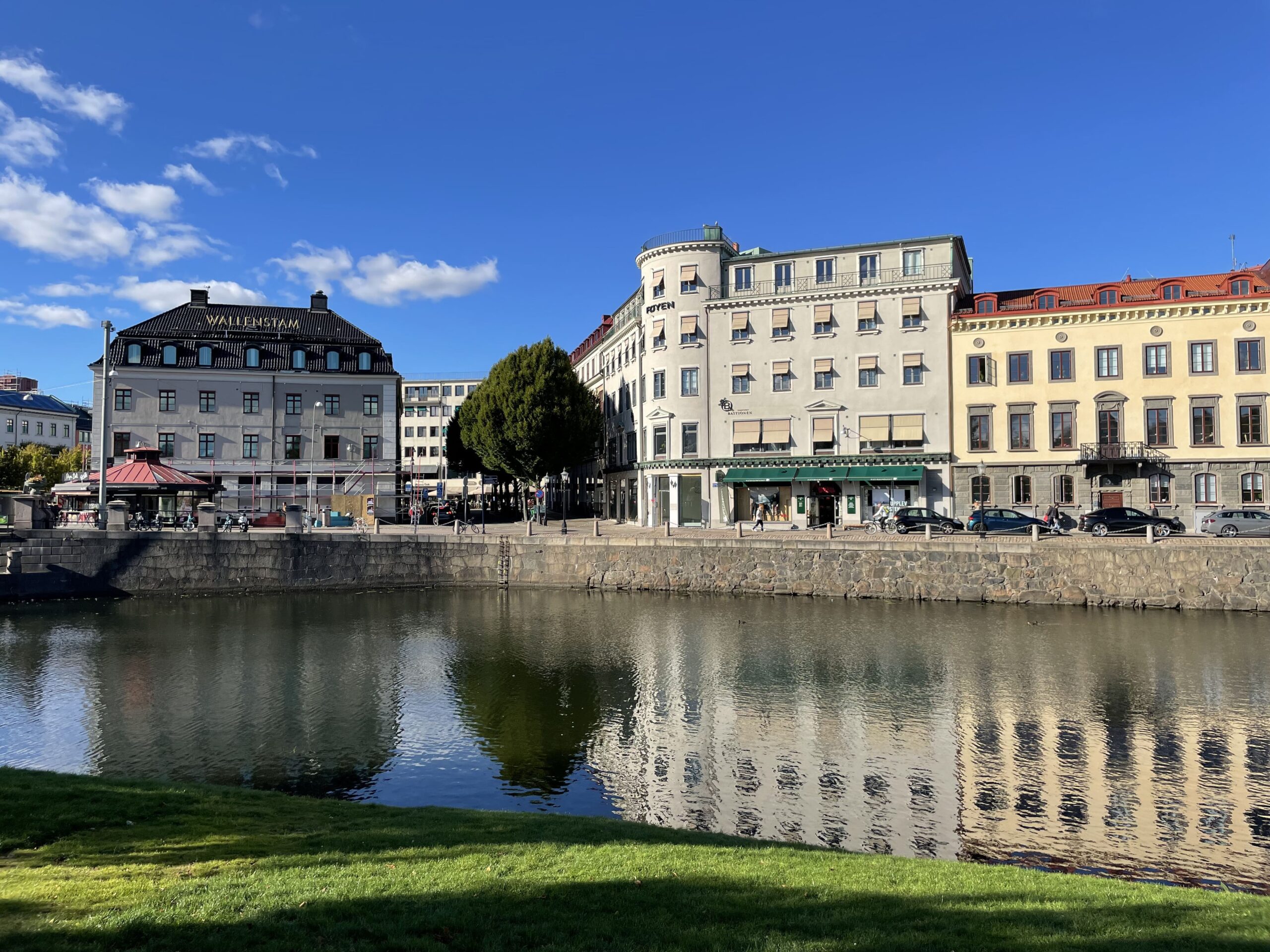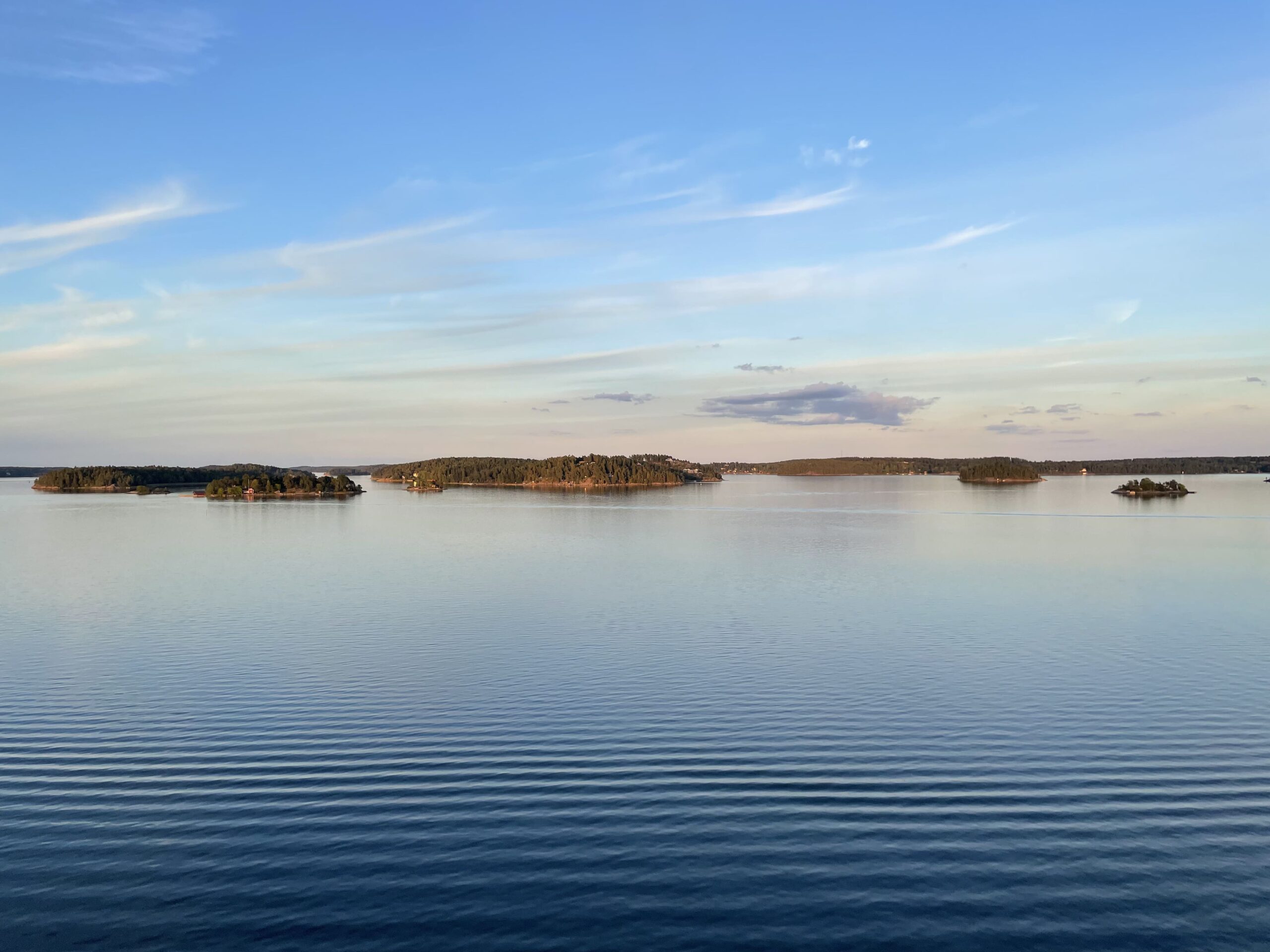<< Introduction
<< Chapter 4: Copenhagen, Malmö, Lund
I left Copenhagen and, after changing trains in Gothenburg, I arrived in Oslo at around 6 p.m.. During the trip, I had some great views on the Nordic countryside and coast, with many beautiful mountains and forests. My hostel in Oslo was the one I paid the most for per night, even though it was the cheapest one in the city, so I was upset when I saw that it was crowded and dirty. Trying to shake off my slight uneasiness, I immediately went to the National Museum, that among its large art collection features the famous first version of The Scream by Edvard Munch.
I went out early the next morning and I visited the Akershus Fortress, a castle located on a seaside hill overlooking Oslo. Moving along the waterfront, I reached the modern Opera House and I climbed the inclined exteriors to the rooftop to get a good view of Oslo and its fjord, before heading to the city center. There, I visited the cathedral and I passed in front of the Storting building, seat of the Parliament of Norway. Continuing on the main street, I reached the large Royal Palace that stands on top of a hill, and I walked around the gardens that surround it.
I then moved on to the Tjuvholmen neighborhood, a recently redeveloped seaside district hosting art galleries and a sculpture park designed by Italian architect Renzo Piano. After crossing the popular Aker Brygge promenade and passing again in front of the National Museum and the Nobel Peace Center, I visited the huge building of the Oslo City Hall. I had lunch in the nearby square with a chilipølse, a Norwegian version of a spicy hot dog similar to those found in Denmark.
Next, I took a ferry to Bygdøy, a peninsula in the Oslo Fjord hosting various museums. Unfortunately now the Viking Ship Museum is closed until at least 2025 while undergoing a renewal, so I just got the combined ticket for the three museums close to the ferry stop. Firstly, I visited the Fram Museum, which is dedicated to polar exploration and hosts the original Fram ship that sailed the Arctic and Antarctic seas between 1893 and 1912. This was the ship used in the first ever expedition to reach the South Pole, led by Norwegian explorer Roald Amundsen. One peculiar highlight of this museum was a narrow hallway that simulates the harsh polar climate, and just walking through it for a few seconds is enough to get you shivering in cold.
The nearby Kon-Tiki Museum is instead dedicated to the raft of the same name that in 1947 crossed the Pacific Ocean from South America to the Polynesian islands. Lastly, I paid a visit to the Maritime Museum, which exhibits the long seafaring tradition of Norway. After taking the ferry back to the city center, I walked to the more hilly area to the north, all the way to the Old Aker Church and finally the picturesque Damstredet, a street with traditional wooden houses.
Aside from the hostel and the prices, that are sometimes prohibitive for someone traveling on a budget like I was, everything else about Oslo was great. It felt much more quiet and peaceful than Copenhagen, also thanks to the many electric cars, and even the weather was more enjoyable despite the low temperatures. I left the next morning, stopping in Gothenburg on my way to Stockholm.
While in Gothenburg, I walked on the seaside road that hosts the local opera house and a casino, before seeing the cathedral. As I was bringing all my luggage with me around the city, I started to get a bit tired and I stopped at a bubble tea shop, where I tried the popular Taiwanese drink for the first time, and I even got a keyring shaped like a bubble tea as a gift. My last stop in Gothenburg was the Trädgårdsföreningen, a pretty botanical garden with a large greenhouse. Even though my visit was very short, I really enjoyed the time I spent in this city.
I arrived in Stockholm after a three-hour train ride from Gothenburg, and again the scenery of the Swedish countryside during the trip was truly delightful. It was almost 10 p.m. when I reached the capital of Sweden and I was a bit surprised by the temperature, only 4 °C. It felt very cold for mid September, but maybe just because I’m used to a warmer climate. The day after I began my tour from the central Drottninggatan pedestrian street, and I headed toward the old town, Gamla Stan.
This part of Stockholm is located on a few islands in the middle of the city’s archipelago, and features many traditional houses and historic buildings. First, I walked past the Parliament House and then I visited the islet of Riddarholmen, enjoying the panoramic view on the Riddarfjärden bay, and stopping at the large Riddarholmen Church where many Swedish monarchs are buried. I didn’t go inside the large Royal Palace or the nearby Storkyrkan, the oldest church of the city, heading straight to the Nobel Prize Museum on Stortorget, the main square of Gamla Stan. There, not only I appreciated the exhibits, but I also had lunch and I got to try the renowned Nobel ice cream, the same served every year at the Nobel banquet.
After walking a bit more around the old town, I headed south to the Stockholm City Museum, and then back to the north side of the city to the Museum of Medieval Stockholm. I then went to see the large art collection of the National Museum, and the Moderna Museet, which hosts modern and contemporary artworks. All four of these museums were among the many free ones in Stockholm. At that point I was already on the Skeppsholmen island, and I kept going until I reached the Kastellet, a small citadel on the Kastellholmen islet. On my way back to the hostel, I stopped at the National Library in the Humlegården park. Hosted in this library is the Codex Gigas, the largest surviving medieval illuminated manuscript in the world.
The following day I walked all the way to the island of Djurgården, where I visited the Vasa Museum. This museum hosts the recovered seventeenth-century warship Vasa, that sinked near Stockholm on her maiden voyage. Lastly, I went to the rich Swedish History Museum, I had a quick lunch, and finally I picked up my luggage at the hostel. From there, I had to go to the cruise terminal to get on the ship to Helsinki, for which I had a discount thanks to my Interrail pass. Since I still had a lot of time, I decided to walk, but it took me more than an hour and it was much more exhausting than what I expected. Nevertheless, I reached the terminal early and I had time to relax and settle down in my room before the cruise departed at 4:30 p.m..
Stockholm felt similar to Copenhagen, busy and a bit expensive, but still charming and enjoyable. The old town is especially remarkable and so are the many free museums. However, I loved the cruise through the Stockholm Archipelago even more. I stayed on the deck of the ship all afternoon, enduring the cold winds, to admire the stunning beauty of the countless small islands that dot this section of the Baltic Sea, marveling in the breathtaking sunset. At around midnight, the cruise quickly stopped in Mariehamn, the capital of Åland, a Swedish-speaking autonomous archipelago that is part of Finland. I would have loved to visit these peculiar islands and my original travel plans actually included a stop here and also one in Turku, but due to cruise times and high costs, I ultimately decided to head directly to Helsinki.
The cruise ship reached the Finnish capital at around 10 a.m. the next morning. I still had a few hours before the check-in time at the hostel so I walked around the city center, firstly on the central Esplanadi avenue, then along the seafront to the tiny island of Tervasaari and the Kaisaniemi Park, and finally in the area around the large Railway Square. For lunch, I went to the seaside Kauppatori market square located between the Esplanadi and the cruise terminal. There, I had a dish of fried vendace, a local fish that inhabits the lakes of Northern Europe.
After checking in in a nice hostel in the city center, I went out again to explore. I quickly reached the Senate Square, which is surrounded by historic buildings and dominated by the large Helsinki Cathedral, symbol of the Finnish capital. I paid a visit to the Helsinki City Museum and then I headed to the Uspenski Cathedral, the main Eastern Orthodox site in Finland, which was unfortunately closed.
To complete my first day in Helsinki, I took a ferry to the sea fortress of Suomenlinna, and I walked around the park and the islands for almost two hours, before going back to the city center. I don’t usually mention my dinners at the hostel because I just cooked something simple, but the one I had in Helsinki is worth a comment. I tried the famed Korean haek-buldak-bokkeum-myeon, a brand of instant noodles considered the spiciest on the market, so much so that just finishing an entire package was a viral online challenge. The one I tried was the hottest version available and I was able to complete it, but it may have been the spiciest food I have ever eaten.
On the morning of my second day in Helsinki, I went to the peaceful seaside Kaivopuisto park and then the business district of Kamppi. I had lunch again in Kauppatori, where this time I tried a hot dog of reindeer meat. In the afternoon, I visited the National Museum of Finland, which features large collections of the history and culture of the country, and then I walked all the way to the peculiar monument dedicated to composer Jean Sibelius. After taking a stroll on the sandy Hietaniemi beach, I saw the Parliament House, before finally picking up my luggage at the hostel and heading toward the port. I arrived in Helsinki on a cruise ship, and I was leaving on a cruise ship. This time heading south, crossing the Gulf of Finland toward Tallinn, Estonia.
As Stockholm felt like Copenhagen, Helsinki instead seemed more similar to Oslo, as both are smaller and calmer, but also more expensive. The many green spaces and long seaside avenues are also among the features that made the capital of Finland one of the most enjoyable stops on my tour. Overall, my time in Northern Europe was great, despite the cold and the high prices that sometimes stopped me from visiting some places or eating more elaborate food. Still, the charming scenery, pleasant atmosphere, and fascinating culture made this part of the trip absolutely satisfying.
Chapter 6: Tallinn, Valga, Riga, Vilnius, Trakai >>











































